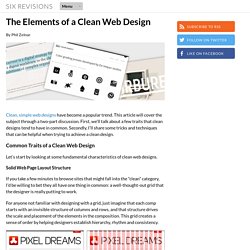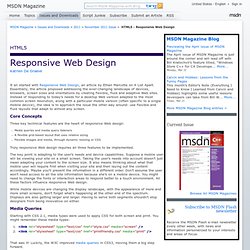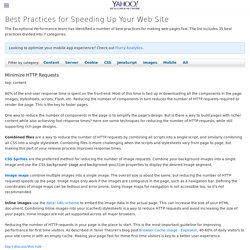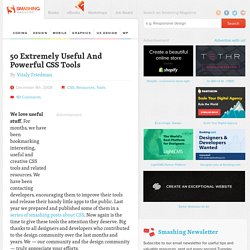Web UI / Design
> Erickbrower
> Programming
HTML Table Style Generator by eli geske. jQuery Scroll Path. The Elements of a Clean Web Design. Clean, simple web designs have become a popular trend.

This article will cover the subject through a two-part discussion. First, we’ll talk about a few traits that clean designs tend to have in common. Secondly, I’ll share some tricks and techniques that can be helpful when trying to achieve a clean design. Common Traits of a Clean Web Design Let’s start by looking at some fundamental characteristics of clean web designs. Solid Web Page Layout Structure If you take a few minutes to browse sites that might fall into the "clean" category, I’d be willing to bet they all have one thing in common: a well-thought-out grid that the designer is really putting to work.
For anyone not familiar with designing with a grid, just imagine that each comp starts with an invisible structure of columns and rows, and that structure drives the scale and placement of the elements in the composition.
Smooth Page Scroll. Pellentesque habitant morbi tristique senectus et netus et malesuada fames ac turpis egestas.

Vestibulum tortor quam, feugiat vitae, ultricies eget, tempor sit amet, ante. Donec eu libero sit amet quam egestas semper. Aenean ultricies mi vitae est. Mauris placerat eleifend leo. Quisque sit amet est et sapien ullamcorper pharetra. Top quam, feugiat vitae, ultricies eget, tempor sit amet, ante.
Jondot/graphene. Colllor - Turn one color into many alternative ones. 6 Best HTML5/CSS3 Presentation Frameworks.
HTML is the most popular web development language in the world, Using this language designers can make web application more attractive and creative.

HTML 5 is the advanced version of HTML and getting popularity among web designers with their advanced features and functionality.
Using CSS without HTML · Mathias Bynens. Big thanks to Mathias Bynens for the guest post today!

I'd call this a bonafide CSS trick! A few days ago, Chris tweeted: If we could stack pseudo elements (e.g. :after:after) we could build a whole website with no HTML other than <html>. Probably good we can’t. In response to this, I created this quick demo (view in Firefox or Opera), illustrating that technically you don’t need any HTML at all to use CSS. Since this demo apparently caused some confusion among tweeps, I decided to write an article about it. Some HTML elements are implied The opening and closing <html>, <head> and <body> tags aren’t required in HTML.
HTML5 - Responsive Web Design.
It all started with Responsive Web Design, an article by Ethan Marcotte on A List Apart.

Essentially, the article proposed addressing the ever-changing landscape of devices, browsers, screen sizes and orientations by creating flexible, fluid and adaptive Web sites. Instead of responding to today’s needs for a desktop Web version adapted to the most common screen resolution, along with a particular mobile version (often specific to a single mobile device), the idea is to approach the issue the other way around: use flexible and fluid layouts that adapt to almost any screen.
Core Concepts Three key technical features are the heart of responsive Web design: Media queries and media query listenersA flexible grid-based layout that uses relative sizingFlexible images and media, through dynamic resizing or CSS Truly responsive Web design requires all three features to be implemented. The key point is adapting to the user’s needs and device capabilities. Media Queries. Best Practices for Speeding Up Your Web Site. The Exceptional Performance team has identified a number of best practices for making web pages fast.

The list includes 35 best practices divided into 7 categories. Minimize HTTP Requests tag: content 80% of the end-user response time is spent on the front-end. Most of this time is tied up in downloading all the components in the page: images, stylesheets, scripts, Flash, etc. One way to reduce the number of components in the page is to simplify the page's design. Combined files are a way to reduce the number of HTTP requests by combining all scripts into a single script, and similarly combining all CSS into a single stylesheet. CSS Sprites are the preferred method for reducing the number of image requests.
Image maps combine multiple images into a single image. Inline images use the data: URL scheme to embed the image data in the actual page.
50 Extremely Useful And Powerful CSS Tools - Smashing Coding. Advertisement We love useful stuff.

For months, we have been bookmarking interesting, useful and creative CSS tools and related resources. We have been contacting developers, encouraging them to improve their tools and release their handy little apps to the public. Last year we prepared and published some of them in a series of smashing posts about CSS1. Now again is the time to give these tools the attention they deserve. Below, we present 50 extremely useful CSS tools, generators, templates and resources. We strongly encourage you to develop these tools further, build on the ideas presented here, release new tools for the public and let us know about them. Please take a look at the following related posts:







